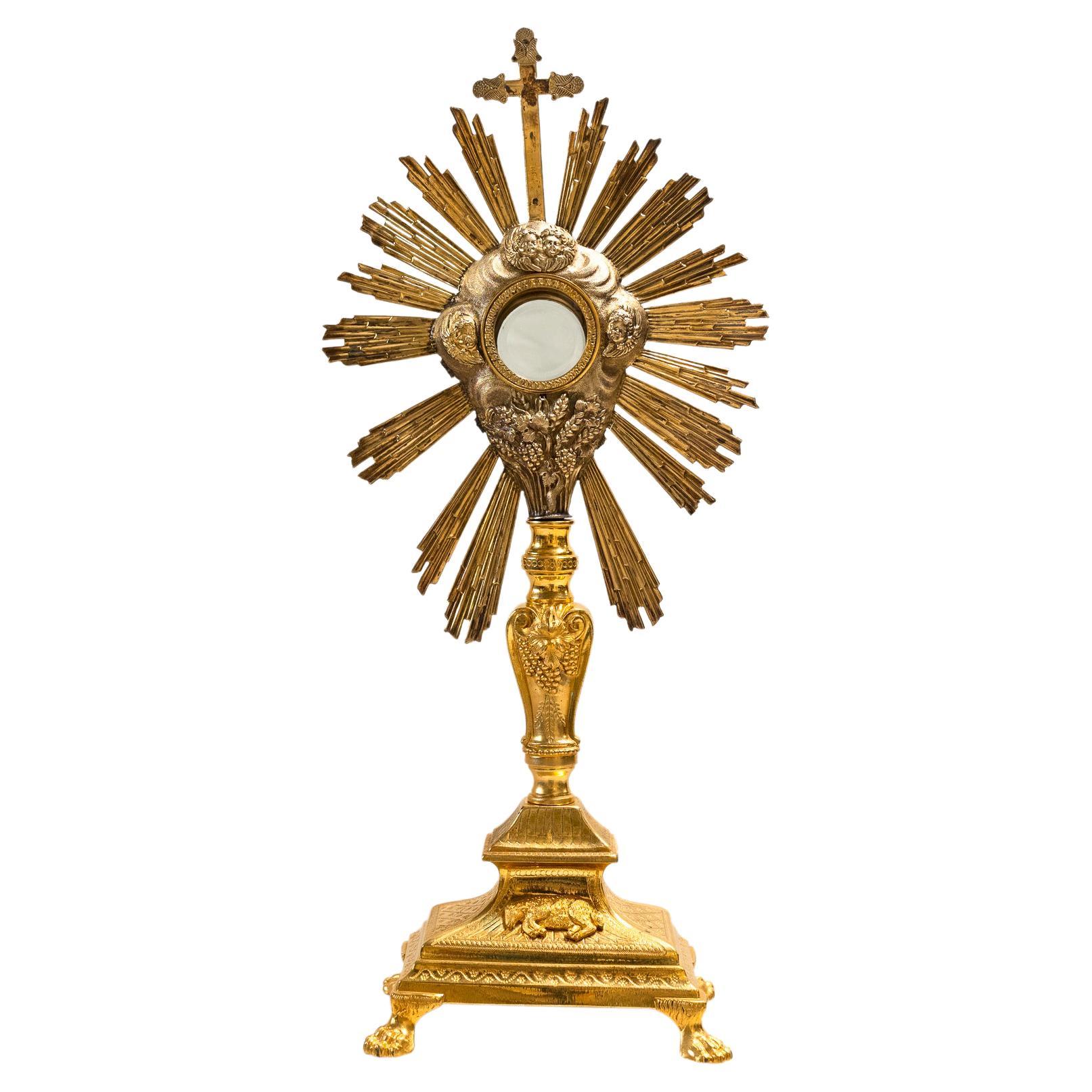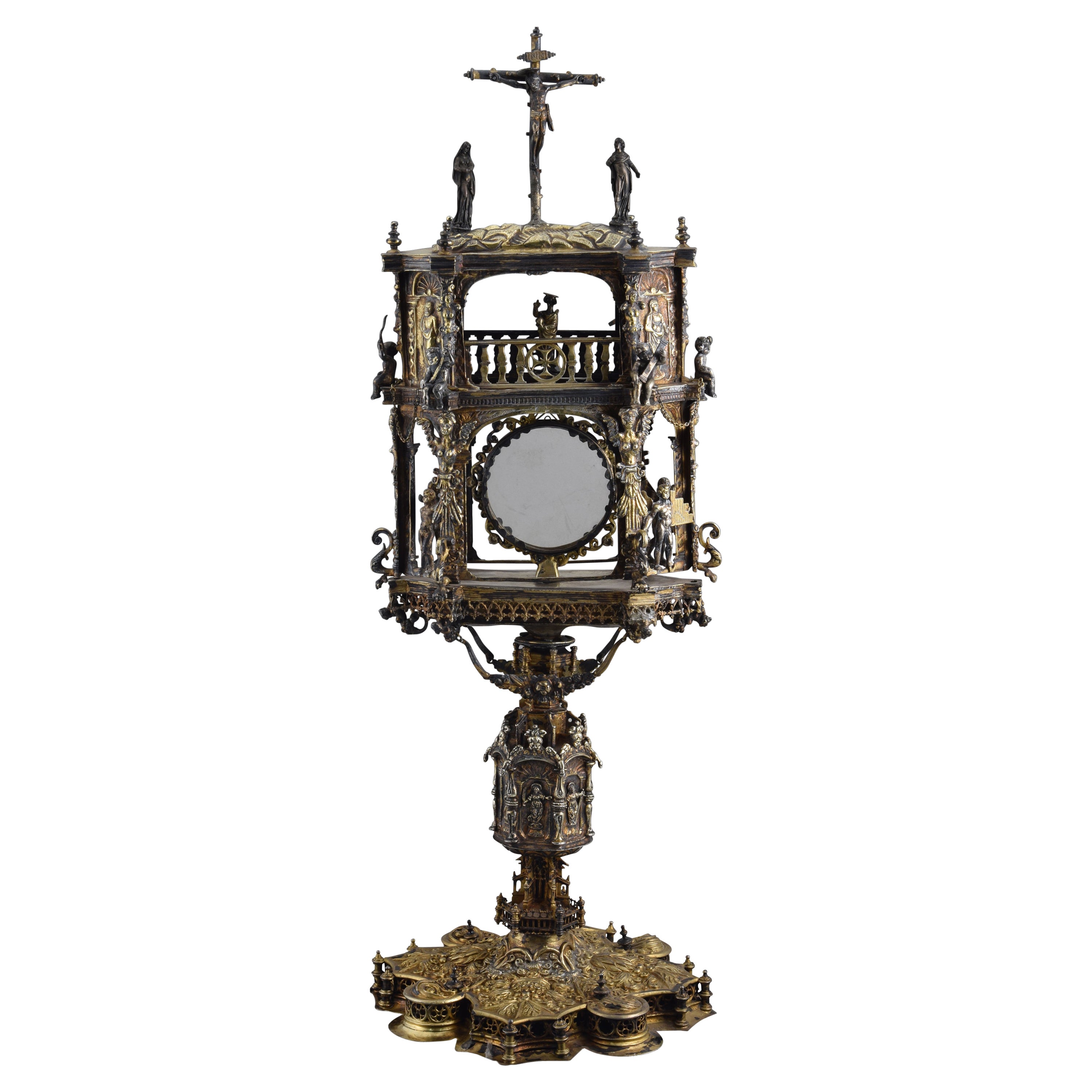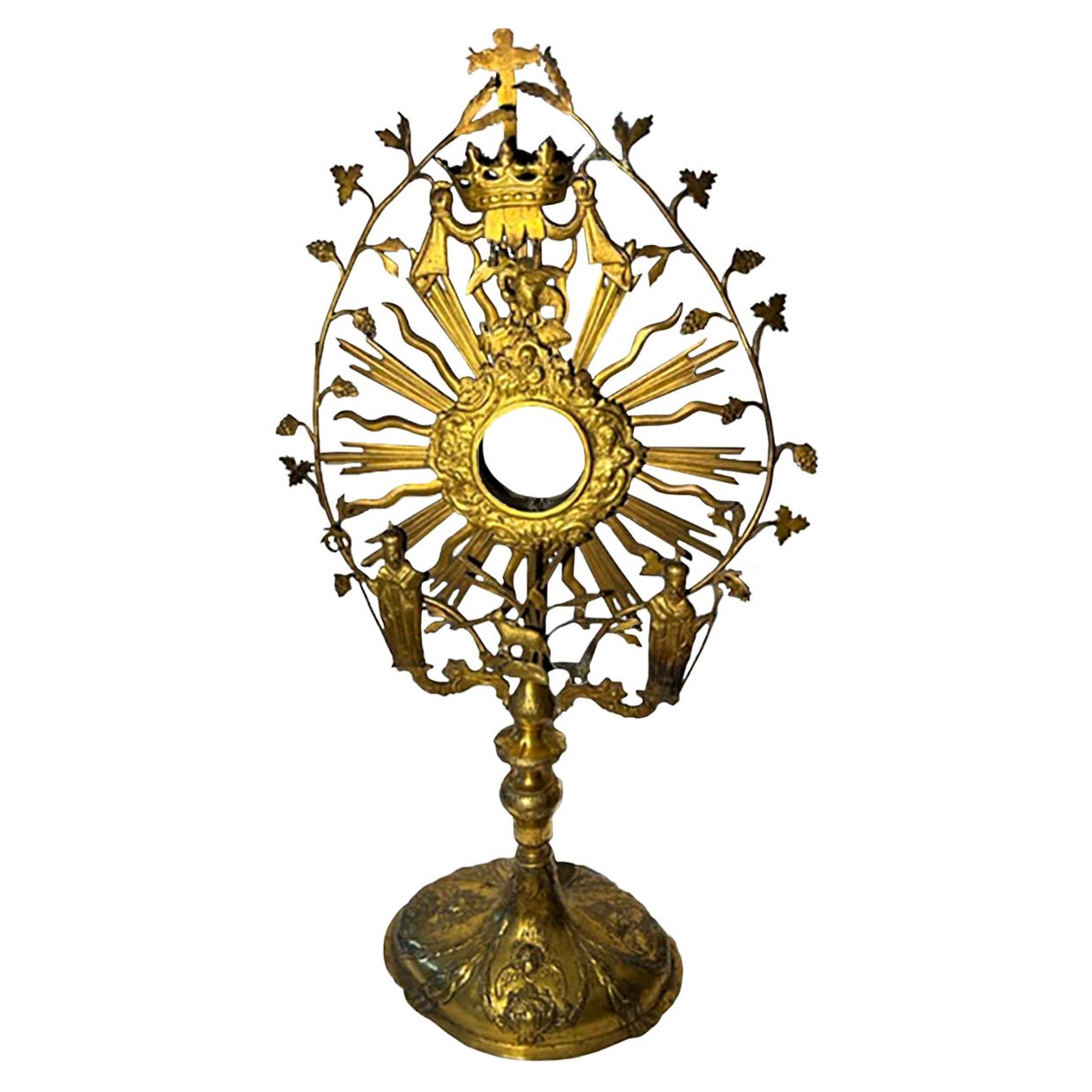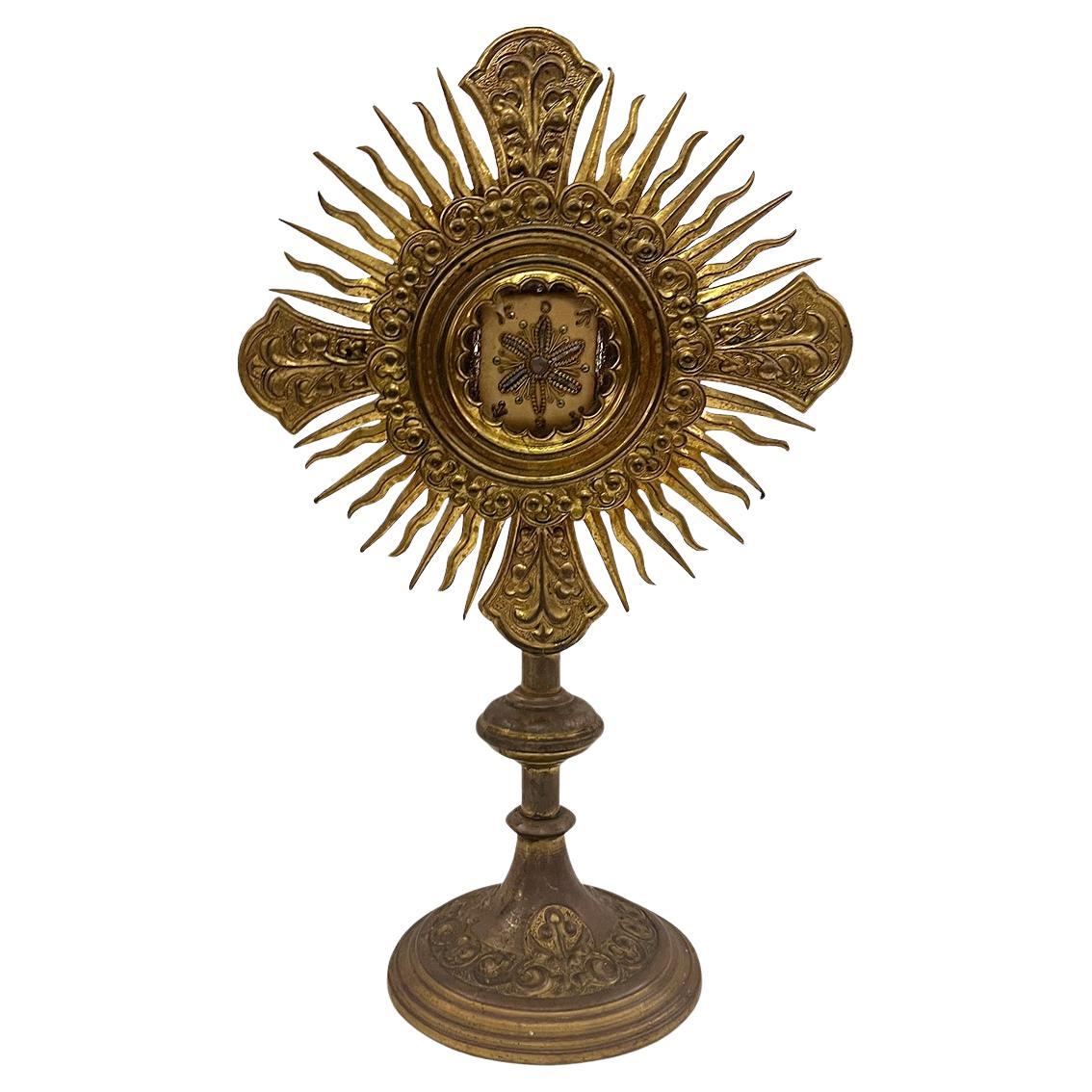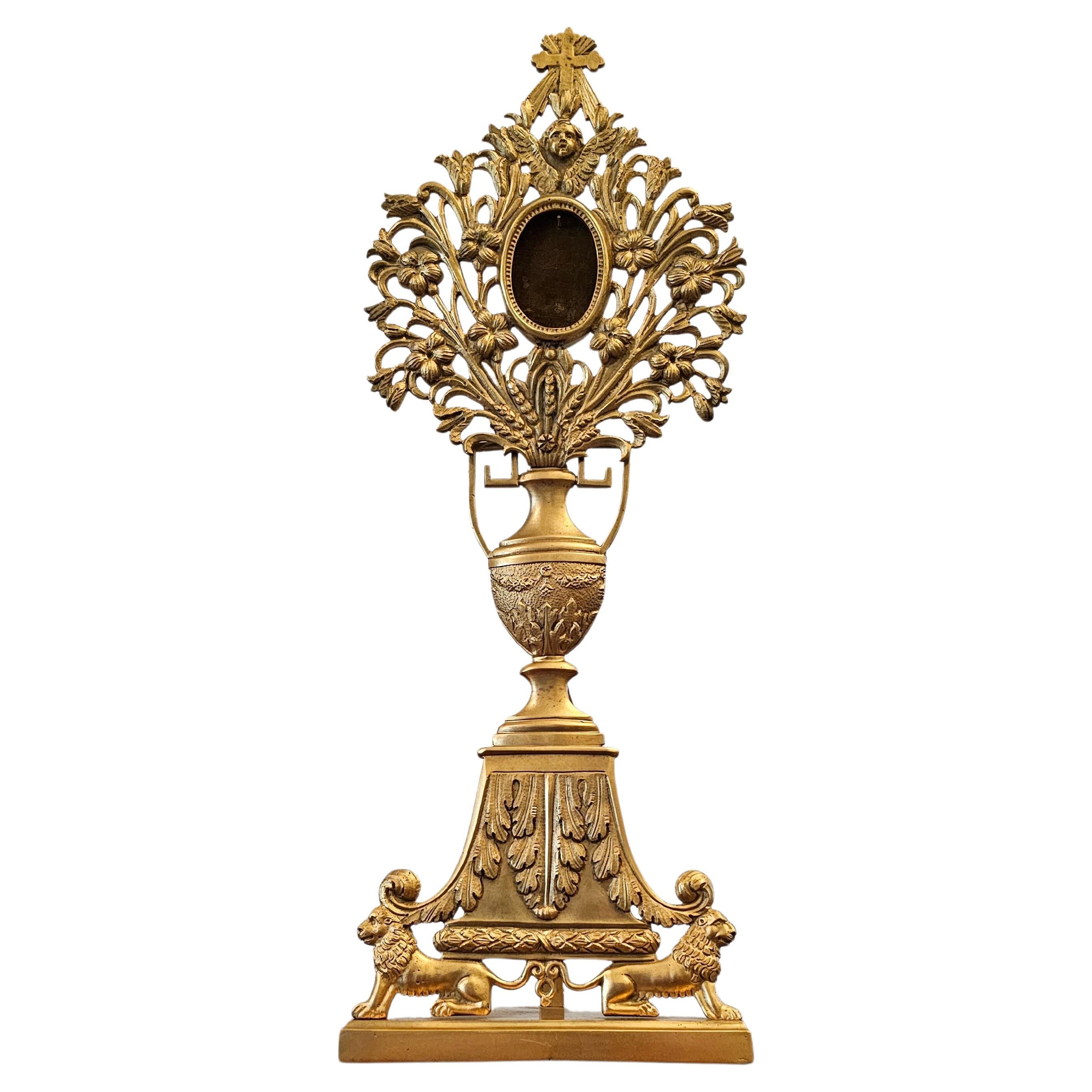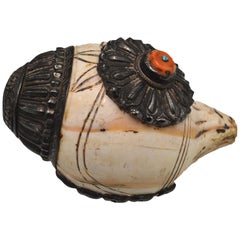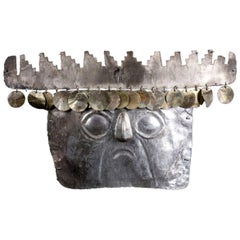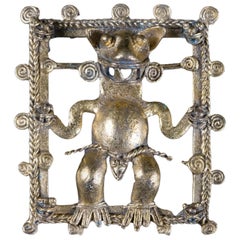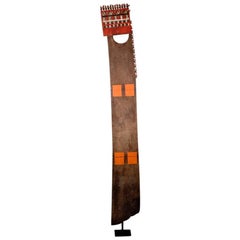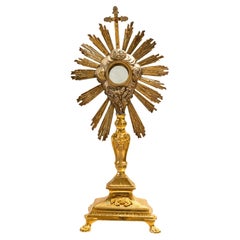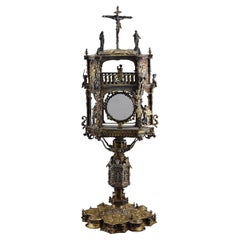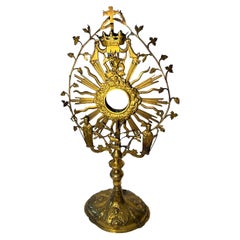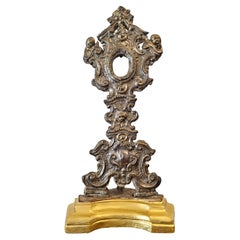Items Similar to Stunning Silver Monstrance, France, 19th Century
Want more images or videos?
Request additional images or videos from the seller
1 of 9
Stunning Silver Monstrance, France, 19th Century
$16,875
£12,932.65
€14,863.80
CA$23,701.77
A$26,526.65
CHF 13,885.75
MX$322,250.70
NOK 176,313.78
SEK 166,382.17
DKK 110,910.12
About the Item
Immaculate silver monstrance or ostensorium over a quadripod rectangular base, decorated with wine branches and small angels heads. French work from 19th century, showing a non determined punch goldsmith mark: J.P., weighing more than two pounds of silver.
- Dimensions:Height: 25.5 in (64.77 cm)Width: 12 in (30.48 cm)Depth: 6 in (15.24 cm)
- Materials and Techniques:
- Place of Origin:
- Period:
- Date of Manufacture:19th Century
- Condition:Wear consistent with age and use. Weight: 2.2 lbs.
- Seller Location:San Pedro Garza Garcia, MX
- Reference Number:Seller: EU-0071stDibs: LU3172311280413
About the Seller
3.7
Vetted Professional Seller
Every seller passes strict standards for authenticity and reliability
1stDibs seller since 2017
24 sales on 1stDibs
Typical response time: 1 to 2 days
- ShippingRetrieving quote...Shipping from: Laredo, TX
- Return Policy
Authenticity Guarantee
In the unlikely event there’s an issue with an item’s authenticity, contact us within 1 year for a full refund. DetailsMoney-Back Guarantee
If your item is not as described, is damaged in transit, or does not arrive, contact us within 7 days for a full refund. Details24-Hour Cancellation
You have a 24-hour grace period in which to reconsider your purchase, with no questions asked.Vetted Professional Sellers
Our world-class sellers must adhere to strict standards for service and quality, maintaining the integrity of our listings.Price-Match Guarantee
If you find that a seller listed the same item for a lower price elsewhere, we’ll match it.Trusted Global Delivery
Our best-in-class carrier network provides specialized shipping options worldwide, including custom delivery.More From This Seller
View AllSacred Silver and Conch Shell Trumpet, Tibet, 19th Century
Located in San Pedro Garza Garcia, Nuevo Leon
Conch shell recipient and container for holy water used in ceremonies. Known as “Buddha ears”, they were mounted as a sound instrument. Such shells are important ritual objects in Tibetan Buddhism...
Category
Antique 19th Century Tibetan Tibetan Scholar's Objects
Materials
Silver
Rare Pre-Columbian Inca Silver Mask with Gold Sequins
Located in San Pedro Garza Garcia, Nuevo Leon
A rare, sheet silver human face mask with simple relief facial features including large, almond shaped eyes and downturned mouth. Classic stepped pyramid headdress with round, very t...
Category
Antique 15th Century and Earlier Peruvian Pre-Columbian Antiquities
Materials
Silver
Supernatural Being, Pre-Columbian Gold Pendant, Costa Rica, circa 800 to 1500 AD
Located in San Pedro Garza Garcia, Nuevo Leon
Southern Costa Rica or Western Panama, circa 800 to 1500 AD. A very fine example of the goldwork of the Veraguas-Chiriqui-Diquis region. A pendant in Carbonera style of a supernatural being, a composite monster with human torso and feline (probably jaguar) head. The figure is set in a frame decorated with little animal heads, one at each corner. The hands have also turned into animal heads. In place of genitalia is a stylized serpent head suspended by a twisted cord that was supposed to continue across the frame. A minor casting accident prevented it form being attached to the frame. A modern goldsmith would solder in two short lengths of twisted wire, but the ancient goldsmith did not have the equipment to make such repair. A double thread ending in spirals goes across the frame behind the neck of the figure, helping to fill up the frame and avoiding a large empty space. The word "thread" reminds us that the twisted and straight cords were, in the original wax model of the pendant really extruded wax threads, turned into metal by the lost wax (cire perdue) process. The braid pattern on the frame is illusory, just two twisted threads of extruded wax laid side by side. The goldsmith made the toes out of extruded wax thread too, very decorative as well. The piece comes with a certificate of authenticity by Mr. Robert Sonin, 5 May 2006. ref. photo roll 3301. A world renowned expert on Pre-Columbian Artifacts...
Category
Antique 15th Century and Earlier Costa Rican Pre-Columbian Figurative Sc...
Materials
Gold
South Coast Wood Ceremonial Leeboard with Open Lattice Designs, Ex-Sotheby's
Located in San Pedro Garza Garcia, Nuevo Leon
A South Coast wood ceremonial leeboard, Ica Valley region, Late Intermediate Horizon, ca. A.D. 1100-1400.
This large 'remo' made from the hard algarrobo wood, features twelve figure...
Category
Antique 15th Century and Earlier Pre-Columbian Figurative Sculptures
Finest Monumental Inca Royal Yupana
Located in San Pedro Garza Garcia, Nuevo Leon
Yupanas were used as calculators or abaci during the Inca Period. This is one of the finest and monumental an example of a Inca table Royal Stone Yupana or...
Category
Antique 15th Century and Earlier Peruvian Pre-Columbian Antiquities
Materials
Stone
Yoruba House Post - Ex-Christie's
Located in San Pedro Garza Garcia, Nuevo Leon
A European functionary, a cane in his right hand, carries a ledger in his left, he wears a visored CAP, collar and tie. He is moustached and has a cigar in his jacket pocket. Probab...
Category
Mid-20th Century Nigerian Figurative Sculptures
Materials
Wood
You May Also Like
19th Century Silver and Gold Monstrance with Travel Case
Located in Ross, CA
A silver and gold monstrance with travel case (c. 1890). Also known as an ostensorium, this vessel was used as a reliquary for display in the private r...
Category
Antique Late 19th Century French Neoclassical Religious Items
Materials
Gold Plate, Silver, Bronze
$2,760 Sale Price
20% Off
Monstrance (temple type). Silver. Spain, 16th century with restorations.
Located in Madrid, ES
Portable temple custody. Gilded silver, glass. 16th century, possible restorations.
Custody made of gilded silver (the finish has been lost in some points) composed of a base, an ax...
Category
Antique 16th Century Spanish Renaissance Religious Items
Materials
Silver, Other
Late 18th Century Gilded Italian Monstrance
Located in Dallas, TX
Monstrance gilded with bishops, bird, lamb and cross. Gilded base with angels is 10” x 7.5”. Circa 1780-1810, Italian.
Category
Antique 1780s Italian Religious Items
Materials
Metal
18th/19th Century Italian Baroque Silvered Metal Altar Monstrance Reliquary
Located in Forney, TX
A stunning antique Italian Baroque style silvered metal gilded wood monstrance reliquary. circa 1770-1820
Handmade in Italy in the late 18th / early 19th century, commissioned by the church to display an important religious relic, sculptural painted wood form, mounted with decorative silver repousse metal facing, open oval window where the philatory relic was once housed, rising on a gold gilt painted shaped plinth base.
Dimensions: (approx)
17" High, 8" Wide, 5" Deep, 1.25lbs
History:
Reliquaries (also referred to as a shrine or châsse in French), are containers used to protect and display relics. A portable reliquary may be called a fereter, and a chapel in which it is housed a feretory. A monstrance, also known as an ostensorium (or an ostensory), is a vessel used in Roman Catholic, Old Catholic, High Church Lutheran and Anglican churches for the display on an altar of some object of piety, such as the consecrated Eucharistic host during Eucharistic adoration or Benediction of the Blessed Sacrament. It is also used as reliquary for the public display of relics of some saints.
The use of reliquaries became an important part of Christian practices from at least the 4th century, initially in the Eastern Churches, which adopted the practice of moving and dividing the bodies of saints much earlier than the West, probably in part because the new capital of Constantinople, unlike Rome, lacked buried saints. Relics are venerated in the Oriental Orthodox, Eastern Orthodox, Roman Catholic and some Anglican Churches. Reliquaries provide a means of protecting and displaying relics. While frequently taking the form of caskets, they range in size from simple pendants or rings to very elaborate ossuaries.
The relics were enshrined in containers crafted of or covered with gold, silver, gems, and enamel. These objects constituted a important form of artistic production across Europe and Byzantium throughout the Middle Ages.
Many were designed with portability in mind, often being exhibited in public or carried in procession on the saint's feast day or on other holy days. Pilgrimages often centered on the veneration of relics. The faithful often venerate relics by bowing before the reliquary or kissing it; those churches which observe the veneration of relics distinguish between the honor given to the saints and the worship that is due to God alone.
Sixteenth-century reformers such as Martin Luther opposed the use of relics since many had no proof of historical authenticity and objected to a cult of saints. Many reliquaries, particularly in northern Europe, were destroyed by Calvinists or Calvinist sympathizers during the Reformation...
Category
Antique Early 19th Century Italian Baroque Sculptures and Carvings
Materials
Metal
Antique Gilt Bronze Reliquary
Located in New York, NY
A late 19th Century French gilt bronze reliquary with removable glass insets that hold an embroidered sachet.
Measurements:
Height: 14.5"
Diameter: 9"
Category
Antique Late 19th Century French Religious Items
Materials
Bronze
Fine 19th Century European Gilt Bronze Ormolu Monstrance Reliquary
Located in Forney, TX
A scarce fine quality neoclassical Empire style vasiform gilt bronze ormolu church religious relic altar monstrance reliquary.
Exquisitely hand-crafted in Continental Europe in the second half of the 19th century, most likely French Napoleon III Period (1852-1870), having a fanned cross crest, above winged angel mask, central oval display...
Category
Antique 19th Century European Empire Sculptures and Carvings
Materials
Bronze, Ormolu
More Ways To Browse
Religious Icon
European Churches
Antique Bibles
Curiosity Shop
Carved Wood Religious
Ecclesiastical Furniture
Antique Catholic
Jesus Christ
Antique Church Collectibles
Gothic Church
Church Cross
Religious Art Wooden
16th Century Spanish
Antique Religious Crosses
Church Doors
Antique Gothic Frame
Antique Metal Cross
Antique Jerusalem
